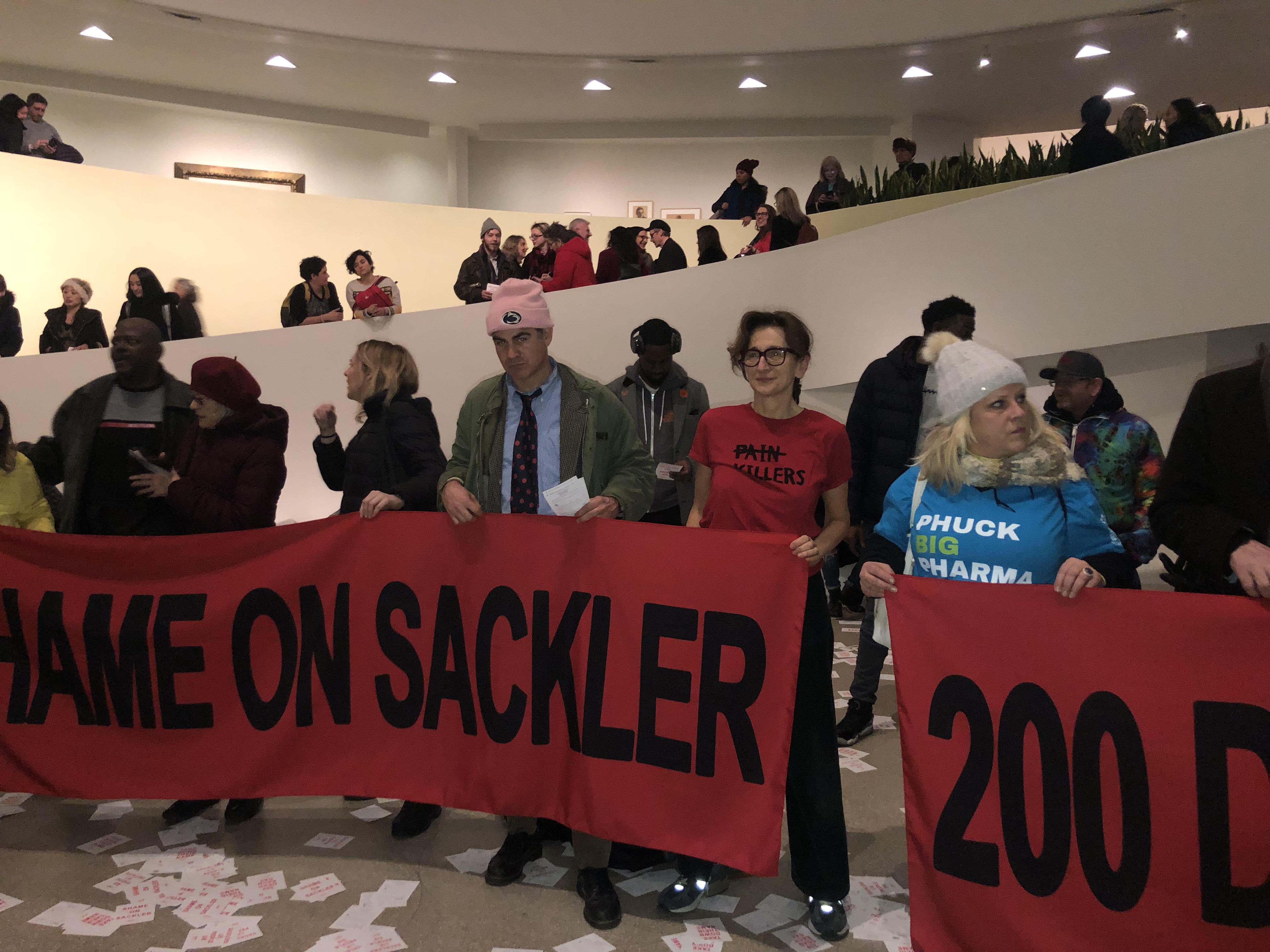
On Saturday evening, more than 100 activists infiltrated the Solomon R. Guggenheim Museum’s famed corkscrew building. A few minutes after 6:30 p.m., four blood-red banners were unfurled on the winding hallways of the museum, reading in bold black letters: “400,000 DEAD,” “SHAME ON SACKLER,” “200 DEAD EACH DAY,” and “TAKE DOWN THEIR NAME.”
The “blizzard” of prescriptions at the Guggenheim Museum. Photo: Caroline Goldstein.
Photo: Caroline Goldstein.
As the crowds of museum goers collectively looked up, a flurry of white paper ‘prescriptions’ rained down. The thousands of xeroxed slips of paper soon littered the lobby floor, bearing the text: “If Oxycontin is uncontrolled, it is highly likely that it will eventually be abused…. How substantially would it improve our sales?” The grim calculus comes from an exchange between OxyContin developer Robert Kaiko and then Purdue Pharma chairman Richard Sackler, son of the company’s co-founder, that was included in court documents and published last month.
Photo: Caroline Goldstein.
This surprise protest was led by Nan Goldin and her organization, P.A.I.N. (Prescription Addiction Intervention Now). Goldin founded the group in January 2018 after publicly acknowledging her personal struggle with opioid addiction and embarking on a mission to both raise awareness and hold the art world accountable for its ties to certain members of the Sackler family, who own Oxycontin manufacturer Purdue Pharma. The Guggenheim, for instance, is home to the Sackler Center for Arts Education, a gift of the “Mortimer D. Sackler Family.” Mortimer Sackler served as co-chairman of Purdue Pharma for more than half a century.
The blizzard of white paper was inspired by another statement by Richard Sackler that emerged in the court documents. In an email, he wrote:
The launch of OxyContin tablets will be followed by a blizzard of prescriptions that will bury the competition. The prescription blizzard will be so deep, dense, and white.
The Sacklers’ internal company communications were made public as part of a court filing that the attorney general of Massachusetts levied against the company, and directly link the family to conscious decisions about how to market the drug. “We have to hammer on abusers in every way possible,” Richard Sackler wrote in another email, from 2001.
The massive group of demonstrators at the Guggenheim had a message of their own, as their de-facto spokesperson, Robert Suarez, told artnet News. “This is akin to genocide,” he said of the opioid crisis, his baritone voice getting hoarser by the minute. “It is an industry that is criminalizing people for being in pain, and profiting on their deaths.” To dramatize the point, the protesters held a “die-in” on the floor of the rotunda, lying on their backs amid the scattered prescriptions and pill bottles, while activists in the crowd chanted “It’s time Guggenheim” and “take down their name.”
Protesters at the Guggenheim. Photo: Caroline Goldstein.
Other activists who travelled to the city for this evening’s event included Michael Galipeau, a co-founder and president of the Rhode Island User’s Union, who brought a contingent from his state to join the protest.
Earlier this week, one of artist-activist Domenic Esposito’s “Opioid Spoon” sculptures was installed outside the Rhode Island outpost of one of Perdue Pharma’s companies, Rhodes Pharmaceuticals.
The Spoon at Purdue HQ. Courtesy of Domenic Esposito.
When asked if his organization had any involvement, Galipeau told artnet News—with a smile—that he had no comment on the action.
After a rousing call-and-response led by Suarez, Goldin herself addressed the growing crowd, re-stating her mission: for the Guggenheim, the Met, and other museums to disavow the Sackler name, and refuse further donations from them.
The protestors extended across the width of Fifth Avenue. Photo: Caroline Goldstein.
The group then gathered outside and filed onto Fifth Avenue to form a parade of marchers, holding the four signs across the width of the thoroughfare as they walked in unison, chanting and blocking traffic.
A handful of officers flanked by a police vehicle asked the protestors to move to the sidewalk, but the group continued down the street en route to its destination: the steps of the Metropolitan Museum of Art.
On Friday afternoon, P.A.I.N. had posted an open call to action to stage a protest on the steps of the Met. This was the first such public call for the group, who usually operate in a more covert manner. The open call, however, made no mention of the Guggenheim demonstration preceding it.
Once settled at the bottom of the steps, the group formed a circle around Goldin, who told the crowd, “We are on the steps of a building paid for by criminals. They should be rotting in jail next to El Chapo.”
Speakers from various activist groups outside the Met. Photo: Caroline Goldstein.
More activists spoke, including Alexis Pleus who described herself as having unknowingly assisted in her son’s death by encouraging him to take the oxycontin he was prescribed. After his prescription ran out, she explained, he turned to heroin, and died alone in a bathroom. As the group dispersed, their collective voices—chanting, “Say it loud, say it clear, the Sacklers are not welcome here”—echoed down Museum Mile.
The “Die-In” at the Guggenheim Museum. Photo: Caroline Goldstein.
In an email to artnet News, a spokesperson for Purdue Pharma wrote, “We share the protesters’ concerns regarding the opioid addiction crisis, and we are committed to working collaboratively with those affected by this public health crisis on meaningful solutions to help stem the tide of opioid-related overdose deaths. We recognize that more needs to be done and that’s why we launched a long-term initiative that continues to build as we pursue a range of solutions that we believe will have a meaningful impact to help address the opioid addiction crisis.”